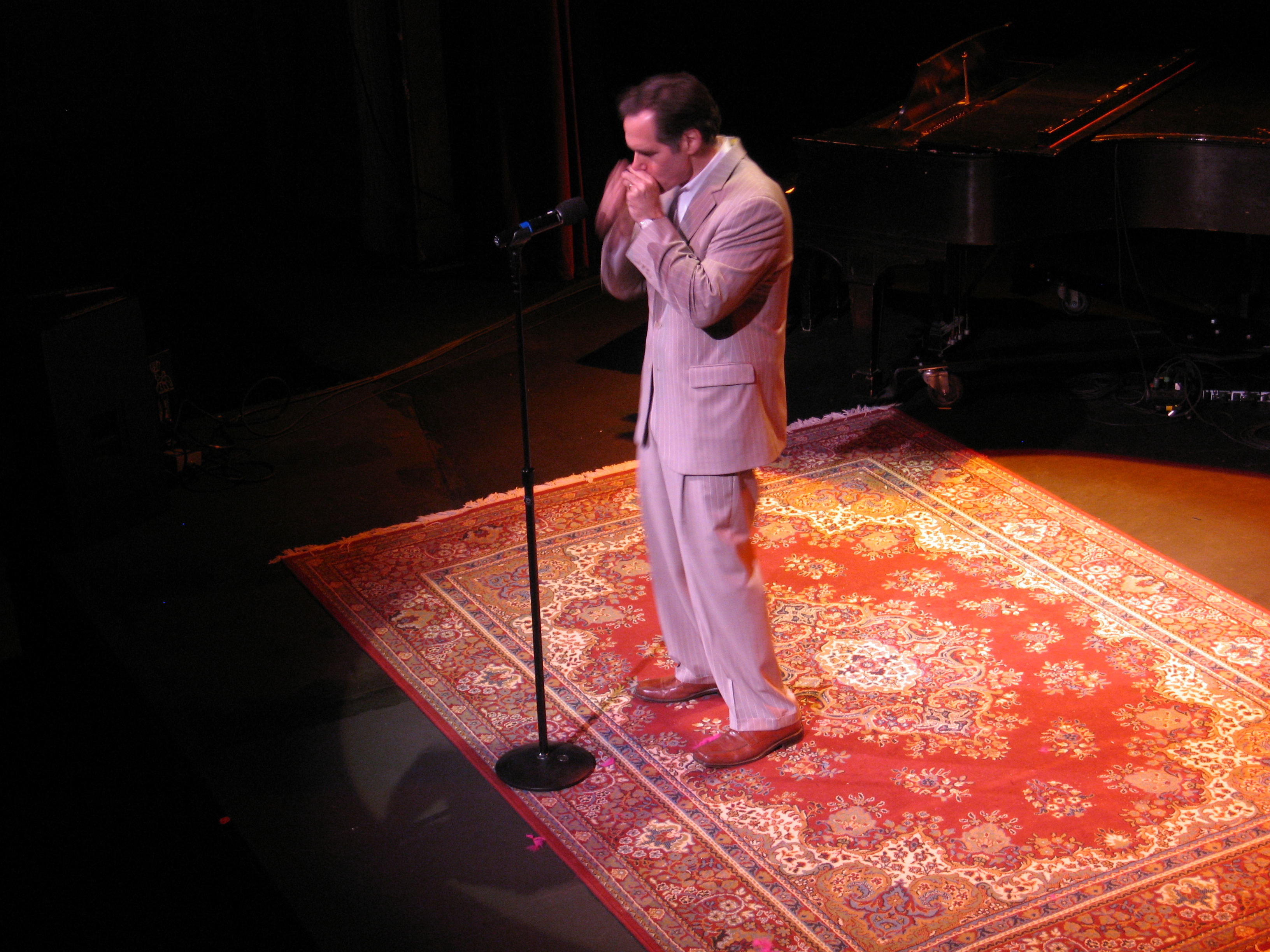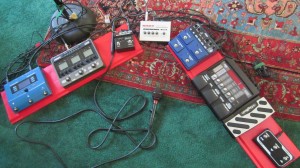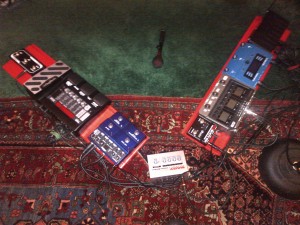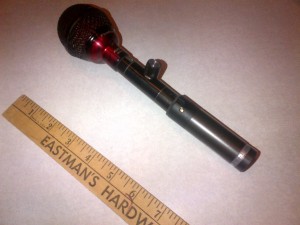
Going Wireless
I’ve been spending time thinking about how to make my rig look smaller and more compact. One of the important approaches to that end is cable management. The most prominent cable on the stage is the one that runs from my harp mic–i.e., from the audience’s point of view, from my face–to the ABY box that feeds my amp modelers. In case you’ve forgotten, here’s a recent picture:

That mic cable takes up a lot of space even when it’s just laying on the floor, huh? There are three other things I don’t like about mic cables:
1) They break, especially if you move them around a lot, like I do with the harp mic.
2) They’re heavy, and you have to move the cable when you move the harp. I wouldn’t describe it as onerous, exactly, but it does make it a little harder to execute fast, precise movements.
3) They tether you to a certain place on the stage–go too far and the mic suddenly jerks from your hand as you reach the end of the cable. A variation on this problem is stepping on the cable in performance, which pulls the mic right out of your hands.
For all these reasons, I decided to go wireless. I didn’t want to mess around–I just wanted to get something that would work right out of the box–so I went straight to Greg Heumann, who knows how to set stuff up for harp, at Blowsmeaway Productions. Greg recommended a Samson Airline 77 system with CR77 receiver and AX1 transmitter, all for well under $300. I bought it.
The setup arrived today. I plugged the power in. I plugged the transmitter into my Audix Fireball and turned the battery on. I took my mic cable and plugged it into the back of the Samson, then plugged the other end (with an inline transformer on it) into the input of my ABY box. Pretty simple, and it all worked on the first try. I opened up the transmitter a little later to adjust its gain according to Greg’s instructions; it was easy and the setup had more level without noticeable distortion.
I moved stuff around a little on my second pedalboard to make room for the Samson. Here’s what the floor setup looks like now to my Blackberry’s camera in a not-very-well-lit room. Even with this decidedly lo-res image, you can see that taking the harp mic cable out of the setup really makes it look cleaner.

Here’s what the mic looks like with one of Greg’s inline volume controls and the transmitter attached. The Audix Fireball is a pretty lightweight mic, with an aluminum body, and the volume control and transmitter add very little apparent weight. Playing while holding the mic seems to take less effort than it does when the mic is cabled, and of course you never step on the cable when you’re playing with a wireless mic.

A wireless setup is a luxury for some players and an absolute necessity for others. If you want maximum room to move onstage (or offstage), it’s in the latter category. At this point in my performing career, I want the room, the gear does the job, and I’ll pay the freight.
Related Posts
4 Comments
Leave a Reply
You must be logged in to post a comment.
WHAT’S NEW
Categories
- Audio/Video
- Blog
- Blue Future
- Digitech RP Tricks and Tips
- Discography, CDs, Projects, Info, Notes
- Featured Video
- For the Beginner
- Gallery
- Hunter's Effects
- Hunter's Music
- Huntersounds for Fender Mustang
- Meet the Pros
- More Video
- MPH: Maw/Preston/Hunter
- My Three Big Contributions
- Player's Resources
- Pro Tips & Techniques
- Recommended Artists & Recordings
- Recommended Gear
- Recorded Performances
- Reviews, Interviews, Testimonials
- The Lucky One
- Uncategorized
- Upcoming Performances
- Zoom G3 Tips and Tricks
Richard —
Have you experienced any difficulty with this unit yet? I’m wondering what the difference is between this one and the SYNTH that Greg sells, which is $100 more. Is there ANY downside? The natural gravity of the cable attached to my Audix wears on me after 90 minutes or so…
Thanks for all you do!
Heath
http://www.reverbnation.com/thebluesprofessors
I haven’t had a problem with the Samson in either practice or performance, EXCEPT when I make the mistake of turning off the transmitter when the base unit is powered up–that produces a very loud blast of white noise, which ends when I turn off the base unit. I’ve trained myself to power the base down first. Otherwise, it sounds good and works reliably. I don’t know what the SYNTH does, so can’t comment. The only possible issue I see with the Samson other than that is that the base unit is made of plastic, so could be damaged if someone steps on it. Careful placement of the thing somewhere off the floor should take care of that.
Richard –
Can you list the pedal boards in your wireless setup that are shown above, left to right?
Heath
http://www.reverbnation.com/thebluesprofessors
Top picture, left board, left to right:
TC Helicon Voicelive Play (for vocals)
Zoom G3 (for guitar and harmonica)
Radial Tonebone A/B/Y switcher (for switching harmonica between G3 or RP355 or both at once)
Between boards: Nady 1 in 4 out mono mixer
right board, left to right:
Digitech Stereo JamMan looper
Digitech RP355
Digitech FS3X footswitch for looper
Note that the Samson wireless is out of frame in the picture. I’ve since changed this setup. The left side board now carries (left to right) the Voicelive Play, the Zoom G3, and the Samson 77 wireless base; the right side board holds the Stereo JamMan and a Digitech RP500 (which I now use instead of the 355 for most performances). In the middle, between the boards, I park the Radial A/B/Y box (whichis now used to switch between microphones), the Nady mixer, the FS3X footswitch for the looper, and the sustain pedal for the keyboard I’ve added to the rig. All signals from all the sound-producing boxes (except the vocals through the Voicelive Play) go into the Nady, and the output of the Nady goes to the Stereo JamMan, where it’s combined with the vocal feed from the Voicelive Play and sent to my powered PA speaker. I’ll provide a picture of the new setup soon.